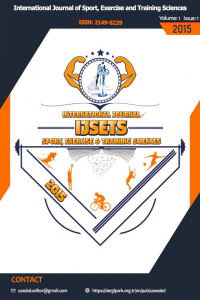1. Ritmik Cimnastik Gençler Dünya Şampiyonası Grup All-Around Sıralamasında puan bileşenlerinin toplam puana etkisi
Amaç: Ritmik cimnastik grup (RGG) rutinlerinde sonuca etki eden skor bileşenlerinin analizi, ileride yapılacak değerlendirme ve müsabaka kurallarında verilecek kararlarda, antrenör ve sporcuların fiziksel hazırlıklarında yol gösterici olabilir. Bu çalışmanın amacı, 2019 yılında ilk kez Rusya Federasyonu'nun Moskova'da düzenlediği 1. Ritmik Cimnastik Gençler Dünya Şampiyonası (WCh) Grup All-Around Sıralama-Alet Elemeleri'nde toplam puan bileşenlerinin toplam puana etkisini belirlemektir. Yöntemler: Bu çalışmada, 5 çember (33 ülke) ve 5 kurdele rutininde (32 ülke) toplam 65 grup rutininin 455 bileşeni analiz edildi. Tüm puan bileşenleri için tanımlayıcı istatistikler ve doğrusal regresyon analizi kullanıldı. Bulgular: 5 çember ve 5 kurdele rutininde D1-2 puanlarının zorluk toplam skora (DTS) etkisi %91 ve %81, D3-4 puanlarının DTS'ye etkisi %99 ve %95, DTS'nin toplam skora (TS) etkisi sırasıyla %98 ve %98, yine E puanı bileşenlerinde de, kesinti E1-2 puanlarının TS üzerindeki etkisi %93 ve %95, kesinti E3-4-5-6 puanlarının uygulama toplam skoru (ETS) üzerindeki etkisi %88 ve %99 olmuştur. ETS'nin TS üzerindeki etkisi sırasıyla %94 ve %97 idi (p<0.001). Her iki rutinde de DTS'nin TS üzerindeki etkisi ETS'den daha fazlaydı. D1-2 ve D3-4 bileşenlerinin 5 çember rutininde DTS üzerindeki etkilerinin 5 kurdele rutinine göre daha yüksek olduğu ve DTS üzerinde en etkili alt bileşenin D3-4 olduğu belirlendi. 5 kurdele rutininde ETS'nin etkisinin 5 çember rutininden daha yüksek olduğu gözlendi. Sonuç: Skor bileşenleri arasında kurulacak iyi bir denge, kompozisyon bütünlüğü için önemlidir. Bir bileşenin baskınlığı, kompozisyon bütünlüğünü bozabilir.
Anahtar Kelimeler:
Ritmik cimnastik grup rutini;, yarışa skorları;, skor analizi
The effect of score components on total score in the Group All-Around Ranking of 1st Rhythmic Gymnastics Junior World Championships
Aim: The analysis of the score components that affect the result in rhythmic gymnastics group (RGG) routines can guide the decisions to be made in the future evaluation and competition rules, and the physical preparation of the coaches and athletes. The aim of the study was to determine the effect of total score components on total score in the Group All-Around RankingApparatus Qualification of 1st Rhythmic Gymnastics Junior World Championships (WCh), which was organized for the first time in 2019, Moscow, Russian Federation.
Keywords:
Group routines, score analysis, ribbon hoop, composition score, execution,
___
- Agopyan, A. (2014). Analysis of body movement difficulties of individual elite rhythmic gymnasts at London 2012 Olympic games finals. Middle - East Journal of Scientific Research, 19(12), 1554– 1565.
- Ávila-Carvalho, L., Klentrou, P., and Levre, E. (2012a). Handling, throws, catches and collaborations in elite group rhythmic gymnastics. Science of Gymnastics Journal, 4, 37–47.
- Ávila-Carvalho, L., Leandro, C., Lebre, E. (2009) Portimão Rhythmic Gymnastics World Cup. Scores analysis. Book of abstracts of the 16th Annual Congress of the European College of Sport Science. Liverpool 2011; pp. 579-80.
- Ávila-Carvalho, L., Lebre, E. (2011). Estudio del valor artístico de los ejercicios de conjunto de Gimnasia Rítmica de la Copa del Mundo de Portimão 2007 y 2008. Apunts. Educación Física y Deportes. 2011, n.º 103. 1.er trimestre, pp. 68-75. ISSN-1577-4015.
- Ávila-Carvalho, L., Palomero, MdL., Klentrou, P., and Lebre, E. (2012b). Analysis of the technical content of elite rhythmic gymnastics group routines. The Open Sports Sciences Journal, 5, 146– 153.
- Federation Internationale De Gymnastique (FIG), (2017). Code de pointage GR 2017-2020, Version mise à jour valable dès le 1er février 2018.
- Ferreirinha, J., Carvalho, J., CôrteReal, C., & Silva, A. (2011). Evolução do Valor Real de Dificuldade dos Exercícios de Paralelas Assimétricas de Ginástas de Elite nos Ultimos Ciclos Olímpicos. In FGP (Ed.), Da Prática à Ciência. Artigos do 2º e 3º Congresso de FGP (pp. 71-78). Lisboa.
- Gymnastics disciplines. Access address: https://www.gymnastics.sport/site/pages/disciplines/ histrg.php, date of access 26 Jan 2021.
- Gymnastics events. Access address: https://www.gymnastics.sport/site/events/searchresults.php, date of access 15 Jun 2021.
- Gymnastics rules. Access address: https://www.gymnastics.sport/site/rules/#5, date of access 15 Jun 2021.
- Jastrejevskaya, N., (1995). Rhythmic Sportive Gymnastics Theory and Practice, FIG, p 140.
- Jastrjembskaia, N., Titov, Y. (1999). Rhythmic Gymnastics, Human Kinetics, p 127-192.
- Kutlay, E., Yardımcı, S. (2007). Analysis of Individual Competition Forms in Rhythmic Gymnastics, 4th International Mediterranean Sport Sciences Congress, 9-11 Kasım, Antalya/Türkiye.
- Leandro, C., Ávila-Carvalho, L., Sierra-Palmeiro, E., and Bobo Arce, M. (2017). Judging in rhythmic gymnastics at diferent levels of performance. Journal of Human Kinetics, 60, 159–165. doi: 10.1515/hukin-2017- 0099.
- Leandro, C., Ávila-Carvalho, L., Sierra-Palmeiro, E., and Bobo Arce, M. (2015). Accuracy in judgment the difficulty score in elite rhythmic gymnastics individual routines. Science of Gymnastics Journal. 7, 81–93.
- Leandro, C., Ávila-Carvalho, L., Sierra-Palmeiro, E., and Bobo Arce, M. (2016). Technical content of elite rhythmic gymnastics. Science of Gymnastics Journal, 8(1), 85 – 96.
- Massidda, M., and Calò, M. C. (2012). Performance scores and standings during the 43rd artistic gymnastics world championships, 2011. Journal of Sports Sciences, 30, 1415–1420. doi: 10.1080/02640414.2012.710759.
- Örs, B. S. The effect of difficulty and execution scores on total ranking during 2019 Rhythmic Gymnastics World Championships (2020). African Educational Research Journal, Special Issue 8 (1), 37-42.
- Sierra-Palmeiro, E., Bobo-Arce, M., Pérez-Ferreirós, A., & Fernández-Villarino, M. A. (2019). Longitudinal Study of Individual Exercises in Elite Rhythmic Gymnastics. Frontiers in psychology, 10, 1496. https://doi.org/10.3389/fpsyg.2019.01496.
- Trifunov, T., and Slovodanka, D. (2013). The structure of difficulties in the routines of the best world and Serbian rhythmic gymnastics. Fiziˇcka Kultura, 67, 120–129. doi: 10.5937/fizkul1302120t.
- Tsopani, D., Dallas, G., Tasika, N., & Tinto, A. (2012). The effect of different teaching system in learning rhythmic gymnastics apparatus motor skills. Science of Gymnastics Journal. 4, 55–62
- ISSN: 2149-8229
- Başlangıç: 2015
- Yayıncı: İbrahim ERDEMİR
